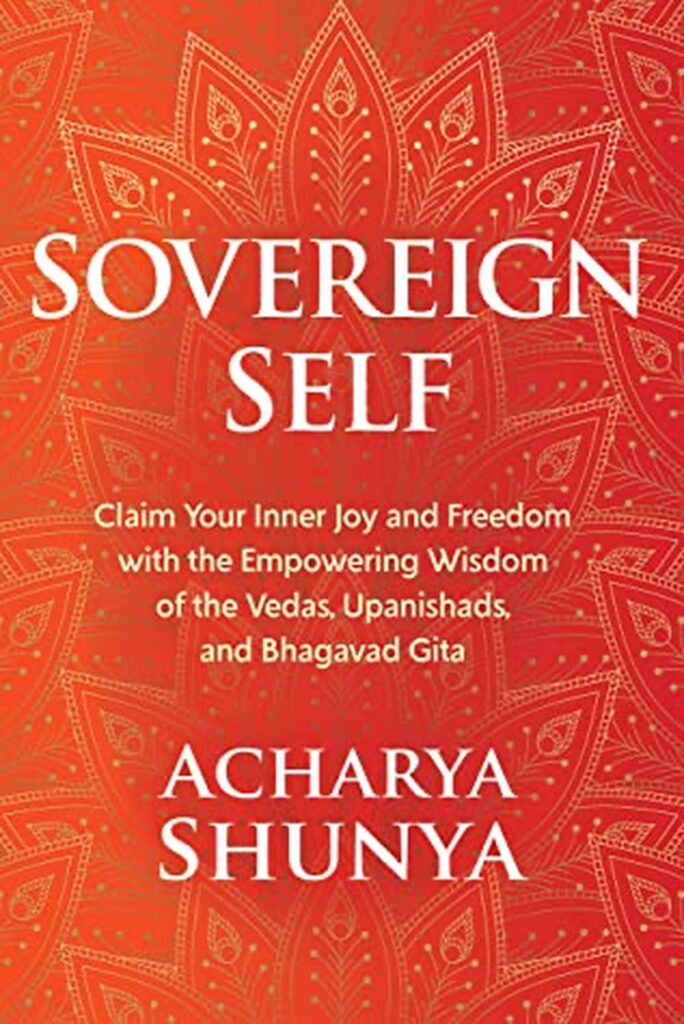Sharing my learnings from the book, Sovereign Self by Acharya Shunya
Sovereign Self by Acharya Shunya
With Sovereign Self, Acharya Shunya shares a groundbreaking guide to the wisdom of these classic texts so that each of us may emancipate ourselves from restrictive belief systems and discover our true nature―that which is always whole, joyful, and free.
As the first female lineage holder in a 2,000-year-old line of spiritual teachers, Shunya provides a rare opportunity to receive these authentic teachings from a genuine Vedic master―one with a distinctly down-to-earth, feminine flavor who never lets us forget that our humanity is to be embodied and enjoyed.

- Thousands of years ago, in ancient India, sages recorded the wisdom that had been revealed to them. The result was the Vedas – a timeless meditation on the big questions of existence, such as “Who am I really?” and “Why aren’t I happier?”
- Divided into four books called the Rig-Veda, Sama-Veda, Yajur-Veda, and Atharva-Veda, they address age-old questions about the nature of existence, suffering, fulfillment, and the afterlife.
- The answers to these questions are said to be without a human author. Instead, this transcendental wisdom was revealed over the ages to male and female sages known as rishis and rishikas.
- At the heart of this wisdom is an extended meditation on the nature of the self, which the Vedas regard as the key to spiritual freedom.
- The word Veda means knowledge in Sanskrit. the Vedas are interested in two different kinds of knowledge.
- dharma, or ethics – knowledge of how to behave justly.
- knowledge of the true self, which the Vedas call atman.
- The rewards of this spiritual quest are great. When you rediscover and reclaim your forgotten self, you are freed from the desires that keep you trapped in a cycle of suffering. And to exit this state of frenzied and unfulfilled being is to discover a deep sense of purpose, belonging, and well-being.
- According to the Vedas, happiness is found within the self. In other words, you are your happiness. As the Bhagavad Gita, another revered Hindu text, puts it, a person who is happy has “achieved the self.” In other words, authentically being yourself brings joy.
- The Vedas contrast this restless search for happiness in the external world with ananda – the inner joy of the true self. Ananda doesn’t require external, pleasure-giving objects. And, unlike sensory pleasures, it doesn’t fade over time. Put simply, it’s a state of non-desiring, where you don’t crave anything and are content to simply be.
- There are two levels of existence.
- the world you share with other people and objects. This is called jagat
- samsara Is a kind of personal mythology where you don’t engage with jagat on its own terms. Instead, you judge it by your own, subjective standards, beliefs, hopes, and expectations.
- The Vedas depict samsara as a state of hypnosis. Once we’re in it, it’s hard to get out. The only way to avoid this trap is to accept jagat on its own terms.
- Whether the desire is for nicotine, fame, sex, or revenge, these cravings direct you away from your inner self and toward the external world – that distracting palace of mirrors we’ve already encountered. The only way out of this trap is to pay closer attention to the nature of your desires.
- Vedas distinguish between healthy and unhealthy ones. The latter, which are called vasanas, are the cause of mental restlessness. These desires are compulsive – they demand to be fulfilled.
- the Vedas don’t call for you to renounce all earthly desires. Instead, they urge you to cultivate healthy desires, or purusharthas.
- Discovering your true self will help you build better relationships. To address questions about the self and union, the Vedas use the Sanskrit term yoga, which means union or “yoking.”
- True yoga happens when you look for an equal partner in life. Once you believe it’s someone else’s job to fulfill your needs, you outsource your well-being. That’s why it’s so important to step up to the plate and take responsibility for your own happiness, which is where viyoga comes in. Viyoga literally means “separation,” but it can more accurately be translated as emotional detachment.
- Viyoga is all about cultivating the most important relationship of all – the relationship you have with your own self. When you embark on this journey toward your true self, you’ll discover your gifts, needs, and priorities.
- Finding your true self, as we’ve seen, is all about calming your restless mind and halting the cycle of thoughts and desires. The oldest technique for achieving this state of mind is meditation.
- According to the Upanishads, the last section of the Vedas, we become what we believe. When we contemplate an idea which reveals our true selves, that idea becomes part of us.
- What should you do when you encounter negative thoughts? As we’ve seen, these thoughts can trigger a cycle that’s hard to escape. To avoid this pitfall, the Vedas recommend a technique called pratipaksha bhavana, which in Sanskrit means “opposite emotion.”
- The idea is this. When you have a thought that sucks you into this trap, simply – and deliberately – think the opposite. Call it deliberate opposite thoughts.
- You can reinforce this technique by extending it to actions. When you see yourself being inconsiderate, make a gesture of accommodation and compromise
- Every time you change your thought or action into its opposite, you’re removing control from your lower self and redelegating it to your higher self – that is, to your sovereign self. With practice, this becomes second nature. The benefits are huge.


Leave a Reply